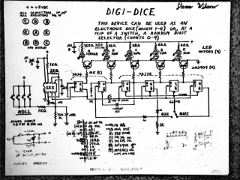This is for historical amusement only - do not build one of these as designed! This project is from high school, when my talent for electronics and science was recognized by the teachers. Maybe I wasn't well-seasoned in the finer points of design, but this thing did function.
Wanting to try out some TTL logic and work with LEDs, i designed this gadget as an electronic replacement for one die. The idea was to use nine LEDs in place of the spots on a die. Actually only seven LEDs would have been sufficient, but i was fascinated with random numbers and wanted to generate random digits from zero to nine. So the thing had nine LEDs and a switch to choose Dice or Digit mode.
 bigger image
bigger image
(when i find the gadget itself, i'll post a photo of it.)
Analyzing the pattern of spots needed, i designed a chain of D flip-flops to generate the right bit pattern. The center "A" light simply alternates. The rest turn on in pairs, each staying as more pairs turn on, until reset. A base one counter, easily implemented as a shift register clocked off the "A" light's flip flop. A little fiddling with diodes and outputs and inputs made it recycle to the "1" state after the "6" or, with the Dice/Digit switch thrown to Digit, to the "0" state from "9".
A 555 timer clocked the logic while any button was pressed down. Four pushbuttons allowed for each player in an average four-player game to have their own button. A simple RC low-pass took care of debouncing, not that it mattered much. I hadn't thought of any clever features like a slow-down to make the stopping of the display more suspenseful, and i didn't want to make a big enough PCB and use up so many parts to make a two-dice display.
The two diodes near the Dice/Digit switch form an OR gate. I was smart enough then to not haul in a whole 14-pin chip just for one little gate.
Why 7400 series TTL for a battery-operated device? It was available. I knew about CMOS - i had written an essay about CMOS back in 8th grade, in fact - but neither i personally nor the electronics lab at school had a pile of 4000 series CMOS chips available to tinker with.
I wonder how long the battery lasted? For some reason at the time i was impressed by the magic powers of Zener diodes. Armed with a little bit of knowledge from the article "Design Your Own Voltage Regulator" by Keith Schuettpelz in the April 1973 Popular Electronics, i used a Zener to regulate the 9V battery supply down to a TTL-pleasing steady 5V. This called for a 2W Zener diode. Don't try this at home unless you own stock in a battery company.
So i bring this digi-dice on the bus to school one morning. One of the girls, a cheerleader iirc, asked "What is that?" After explaining it was an electronic dice, not much more was said. I can only assume that the stunned silence was due to encountering technology far beyond any 20th Century person's wildest imagination.